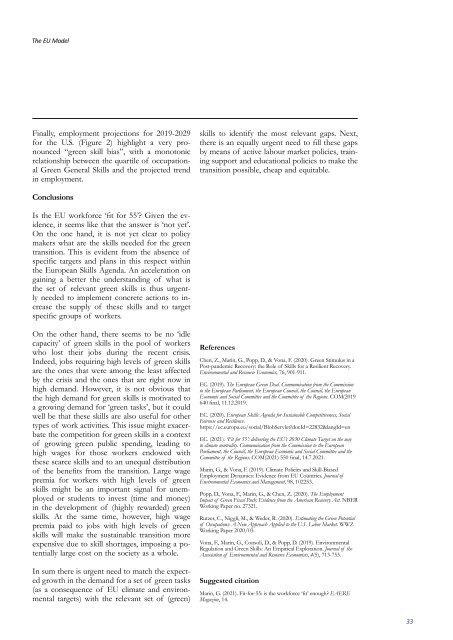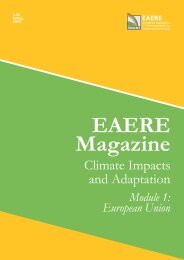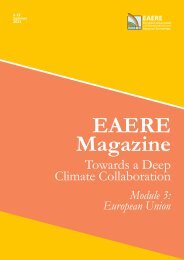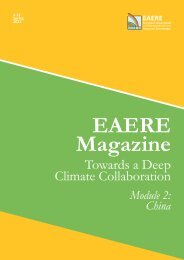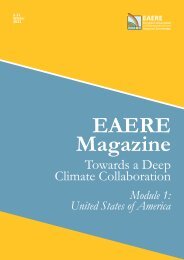EAERE Magazine - N.14 Fall 2021
You also want an ePaper? Increase the reach of your titles
YUMPU automatically turns print PDFs into web optimized ePapers that Google loves.
The EU Model<br />
Finally, employment projections for 2019-2029<br />
for the U.S. (Figure 2) highlight a very pronounced<br />
“green skill bias”, with a monotonic<br />
relationship between the quartile of occupational<br />
Green General Skills and the projected trend<br />
in employment.<br />
skills to identify the most relevant gaps. Next,<br />
there is an equally urgent need to fill these gaps<br />
by means of active labour market policies, training<br />
support and educational policies to make the<br />
transition possible, cheap and equitable.<br />
Conclusions<br />
Is the EU workforce ‘fit for 55’? Given the evidence,<br />
it seems like that the answer is ‘not yet’.<br />
On the one hand, it is not yet clear to policy<br />
makers what are the skills needed for the green<br />
transition. This is evident from the absence of<br />
specific targets and plans in this respect within<br />
the European Skills Agenda. An acceleration on<br />
gaining a better the understanding of what is<br />
the set of relevant green skills is thus urgently<br />
needed to implement concrete actions to increase<br />
the supply of these skills and to target<br />
specific groups of workers.<br />
On the other hand, there seems to be no ‘idle<br />
capacity’ of green skills in the pool of workers<br />
who lost their jobs during the recent crisis.<br />
Indeed, jobs requiring high levels of green skills<br />
are the ones that were among the least affected<br />
by the crisis and the ones that are right now in<br />
high demand. However, it is not obvious that<br />
the high demand for green skills is motivated to<br />
a growing demand for ‘green tasks’, but it could<br />
well be that these skills are also useful for other<br />
types of work activities. This issue might exacerbate<br />
the competition for green skills in a context<br />
of growing green public spending, leading to<br />
high wages for those workers endowed with<br />
these scarce skills and to an unequal distribution<br />
of the benefits from the transition. Large wage<br />
premia for workers with high levels of green<br />
skills might be an important signal for unemployed<br />
or students to invest (time and money)<br />
in the development of (highly rewarded) green<br />
skills. At the same time, however, high wage<br />
premia paid to jobs with high levels of green<br />
skills will make the sustainable transition more<br />
expensive due to skill shortages, imposing a potentially<br />
large cost on the society as a whole.<br />
In sum there is urgent need to match the expected<br />
growth in the demand for a set of green tasks<br />
(as a consequence of EU climate and environmental<br />
targets) with the relevant set of (green)<br />
References<br />
Chen, Z., Marin, G., Popp, D., & Vona, F. (2020). Green Stimulus in a<br />
Post-pandemic Recovery: the Role of Skills for a Resilient Recovery.<br />
Environmental and Resource Economics, 76, 901-911.<br />
EC. (2019). The European Green Deal. Communication from the Commission<br />
to the European Parliament, the European Council, the Council, the European<br />
Economic and Social Committee and the Committee of the Regions. COM(2019<br />
640 final, 11.12.2019.<br />
EC. (2020). European Skills Agenda for Sustainable Competitiveness, Social<br />
Fairness and Resilience.<br />
https://ec.europa.eu/social/BlobServlet?docId=22832&langId=en<br />
EC. (<strong>2021</strong>). ‘Fit for 55’: delivering the EU’s 2030 Climate Target on the way<br />
to climate neutrality. Communication from the Commission to the European<br />
Parliament, the Council, the European Economic and Social Committee and the<br />
Committee of the Regions. COM(<strong>2021</strong>) 550 final, 14.7.<strong>2021</strong>.<br />
Marin, G., & Vona, F. (2019). Climate Policies and Skill-Biased<br />
Employment Dynamics: Evidence from EU Countries. Journal of<br />
Environmental Economics and Management, 98, 102253.<br />
Popp, D., Vona, F., Marin, G., & Chen, Z. (2020). The Employment<br />
Impact of Green Fiscal Push: Evidence from the American Recovery Act. NBER<br />
Working Paper no. 27321.<br />
Rutzer, C., Niggli, M., & Weder, R. (2020). Estimating the Green Potential<br />
of Occupations: A New Approach Applied to the U.S. Labor Market. WWZ<br />
Working Paper 2020/03.<br />
Vona, F., Marin, G., Consoli, D., & Popp, D. (2019). Environmental<br />
Regulation and Green Skills: An Empirical Exploration. Journal of the<br />
Association of Environmental and Resource Economists, 4(5), 713-753.<br />
Suggested citation<br />
Marin, G. (<strong>2021</strong>). Fit-for-55: is the workforce ‘fit’ enough? <strong>EAERE</strong><br />
<strong>Magazine</strong>, 14.<br />
33


